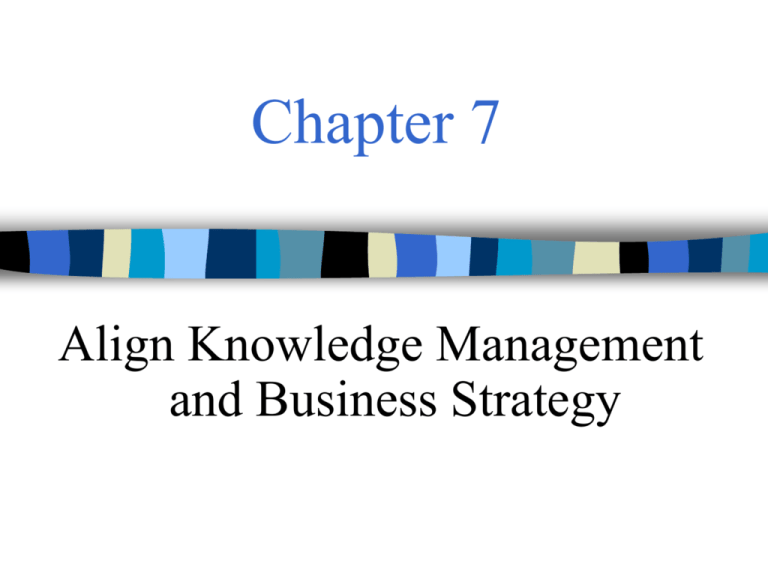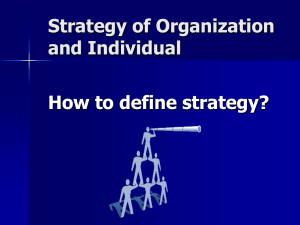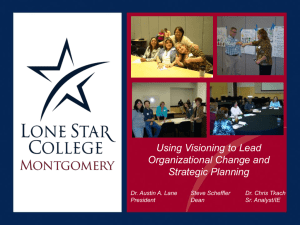Align Knowledge Management and Business Strategy
advertisement

Chapter 7 Align Knowledge Management and Business Strategy Strategic Visioning Creativity without strategy is called art. Creativity with strategy is called good design. Chapter 7 Knowledge Management 2 Strategic Visioning Determine the right diagnostic questions to ask. Knowing the right answers .... to the wrong questions.... will not serve KM project. Chapter 7 Knowledge Management 3 Strategic Visioning 1. 2. 3. What is the industry context in which your company operate? What is the level and nature of turbulence (disturbed) within it. How profound (obvious) is the uncertainty in your business. Chapter 7 Knowledge Management 4 Knowledge Transfer & Knowledge Integration Chapter 7 Knowledge Management 5 Knowledge Transfer Vision: General strategy of facilitating learning and exchange. The two transacting individuals posses certain shared knowledge in order to effectively communicate. – ถ้ามาจากคนละหน่วยงาน จะมีส่วนที่จะแบ่งปั นความรู ้กนั น้อยมาก Sufficient time is available to engage in such transfer. – ถ้ามีเวลาจากัดในการพัฒนา KM จะมีปัญหาเกี่ยวกับเวลาในการสอนงานกันน้อยเกินไป Knowledge that is transferred remains valid by the time a transfer is completed. – Project specific knowledge อาจไม่ได้ใช้อีก ในงานประจา Chapter 7 Knowledge Management 6 Knowledge Integration Vision: Stresses (เน้น) rapid application of existing but disconnected knowledge . Knowledge assets are of little value if they cannot be mobilized rapidly. Promote synthesis of individually held knowledge at the task level. Keep cross-member learning down to bare-minimum level. Chapter 7 Knowledge Management 7 Real option under uncertainty Vision: When increasing high uncertainty of markets, technologies, and customer desires, the right strategic bets have high payoffs. Clarity of future (คาดการณ์ได้ชดั เจน) Absolute ambiguity (มืดแปดด้าน) Chapter 7 Knowledge Management 8 Level of uncertainty Level 4 Absolute Unpredictability Level 3 Range of Outcome Level 2 Discrete Possibilities Level 1 Chapter 7 Predictable Outcome Knowledge Management 9 Level of uncertainty Level 1 : Clarity of future (คาดการณ์ได้ชดั เจน) – SWOT Analysis : Strengths, Weaknesses, Opportunities, and Threats Vision: Chapter 7 To sustain the company’s strengths, mitigate its weaknesses, avoid threats, and gab opportunities. Knowledge Management 10 Level of uncertainty Level 2 : Several outcomes are foreseeable. – SWOT Analysis : Strengths, Weaknesses, Opportunities, and Threats Vision: Investments create options that allow their company to change course ... to adapt to a different discrete goal if the market condition is demand. Chapter 7 Knowledge Management 11 Level of uncertainty Level 3 : Range of possible outcomes – Pilot trails, test markets – Ongoing experience is the KEY.. – Consider historically similar patterns • Example : “Internet base business” – AM/FM war – AD/CD electronic standard – Video cassette player standard (VHS and Beta) Vision: Helping the company move in a general direction within the relative fuzzy range of the outcomes. Chapter 7 Knowledge Management 12 Level of uncertainty 4 : Absolute ambiguity (มืดแปดด้าน) - Example : Wireless internet (2003) - Consider historically similar patterns Level Vision: Shaping both the business and the market in ways that help a company’s offering succeed in high unpredictable markets. Chapter 7 Knowledge Management 13 Strategic Visioning Focus on their core competencies and tie those in very tightly to the business strategy and vision. Speed of new product launches. The faster the product is bought to market, the faster the company can recoup its development costs and generate higher profits. Chapter 7 Knowledge Management 14 The responsiveness quadrahedron people come from difference background ต้ องการความหลากหลาย similar domains of expertise Chapter 7 ต้ องการความเร็ว Knowledge Management 15 Permutation of business models and technology influence strategic choices to arrange operational strategy Chapter 7 Knowledge Management customer, partners, supplier transformation strategy 16 Business model and executability Amazon.com – – Chapter 7 lacking deep knowledge of individual customers’ preferences, uses theirs self-selected navigational behavior to customized offerings to each individual’s tastes Knowledge Management 17 Codification and Personalization See Table 6-1 Codification : (To arrange or systematize) Providing high quality, reliable, fast, and cost effective services. Price based competition IT is a primary enable. Reward employees for using and contributing to DB e.g. Pizza Hut, Dell Computer Chapter 7 Knowledge Management 18 Codification and Personalization Personalization : Provide creative and highly customized services and products Expertise-based pricing Use IT for communication and not storage and retrieval Reward employees for directly share their knowledge with colleagues e.g. Private investigator, Boeing For any KM to be successfully, both approach must be present in the difference weight. Knowledge Management Chapter 7 19 Chapter 7 Knowledge Management 20 Chapter 7 Knowledge Management 21 Chapter 7 Knowledge Management 22 Chapter 7 Knowledge Management 23 A high-level of strategic knowledge gap analysis Chapter 7 Knowledge Management 24 Knowledge maps to link knowledge to strategy Core Knowledge 1. HW : chip SW : graphic design skill 2. Advance Knowledge make your company competitively viable (capable of success). - user friendly SW (warning online when we have the phone call) Innovative knowledge make your company lead its entire industry 3. Chapter 7 - allows a company to change the rules of the game - Apple and Microsoft lawsuit in 1980 (look and feel of its Knowledge Management GUI) 25 Creating a Knowledge Map Knowledge is not static. What is innovative knowledge today will become the core knowledge of tomorrow. Chapter 7 Knowledge Management 26 Create a knowledge map to evaluate corporate knowledge Where are we? Where are they? Chapter support 7 e.g. Customer Knowledge Management 27 Innovate or Imitate Intel : dominance in the microprocessor business Choose adopt innovation Celeron : less the cache memory Cyrix (Taiwan): low cost pentium clones AMD : Choose adopt innovation Super 7 year 1999 Chapter 7 Knowledge Management 28 Aligning knowledge and business strategy Chapter 7 Knowledge Management 29 The process of articulating the link between business and knowledge strategies Chapter 7 evaluate utilize Knowledge Management to investigate 30 A recap on strategic alignment Chapter 7 Knowledge Management 31 Assessing (Evaluating) Focus 1. 2. 3. 4. 5. 6. How can we turn Knowledge into something that add value to the markets? How can we generate meaning knowledge? What do we know about the customers? How can we crate knowledge-supportive organization culture. Can we cut cost or reduce time to market, improve customer service, or increase margins? How can we manage people? Chapter 7 Knowledge Management 32 Selecting Key Players Chapter 7 Knowledge Management 33 เพียงเมื่อท่านหยุดกา้ ว ท่านกเ็ ริ่ มถอยหลังแล้ว ดร.เทียม โชควัฒนา










